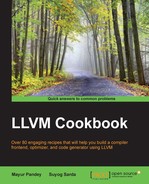A programmer might have come across compilers at some or the other point when programming. Simply speaking, a compiler converts a human-readable, high-level language into machine-executable code. But have you ever wondered what goes on under the hood? A compiler does lot of processing before emitting optimized machine code. Lots of complex algorithms are involved in writing a good compiler.
This book travels through all the phases of compilation: frontend processing, code optimization, code emission, and so on. And to make this journey easy, LLVM is the simplest compiler infrastructure to study. It's a modular, layered compiler infrastructure where every phase is dished out as a separate recipe. Written in object-oriented C++, LLVM gives programmers a simple interface and lots of APIs to write their own compiler.
As authors, we maintain that simple solutions frequently work better than complex solutions; throughout this book, we'll look at a variety of recipes that will help develop your skills, make you consider all the compiling options, and understand that there is more to simply compiling code than meets the eye.
We also believe that programmers who are not involved in compiler development will benefit from this book, as knowledge of compiler implementation will help them code optimally next time they write code.
We hope you will find the recipes in this book delicious, and after tasting all the recipes, you will be able to prepare your own dish of compilers. Feeling hungry? Let's jump into the recipes!
Chapter 1, LLVM Design and Use, introduces the modular world of LLVM infrastructure, where you learn how to download and install LLVM and Clang. In this chapter, we play with some examples to get accustomed to the workings of LLVM. We also see some examples of various frontends.
Chapter 2, Steps in Writing a Frontend, explains the steps to write a frontend for a language. We will write a bare-metal toy compiler frontend for a basic toy language. We will also see how a frontend language can be converted into the LLVM intermediate representation (IR).
Chapter 3, Extending the Frontend and Adding JIT Support, explores the more advanced features of the toy language and the addition of JIT support to the frontend. We implement some powerful features of a language that are found in most modern programming languages.
Chapter 4, Preparing Optimizations, takes a look at the pass infrastructure of the LLVM IR. We explore various optimization levels, and the optimization techniques kicking at each level. We also see a step-by-step approach to writing our own LLVM pass.
Chapter 5, Implementing Optimizations, demonstrates how we can implement various common optimization passes on LLVM IR. We also explore some vectorization techniques that are not yet present in the LLVM open source code.
Chapter 6, Target-independent Code Generator, takes us on a journey through the abstract infrastructure of a target-independent code generator. We explore how LLVM IR is converted to Selection DAGs, which are further processed to emit target machine code.
Chapter 7, Optimizing the Machine Code, examines how Selection DAGs are optimized and how target registers are allocated to variables. This chapter also describes various optimization techniques on Selection DAGs as well as various register allocation techniques.
Chapter 8, Writing an LLVM Backend, takes us on a journey of describing a target architecture. This chapter covers how to describe registers, instruction sets, calling conventions, encoding, subtarget features, and so on.
Chapter 9, Using LLVM for Various Useful Projects, explores various other projects where LLVM IR infrastructure can be used. Remember that LLVM is not just a compiler; it is a compiler infrastructure. This chapter explores various projects that can be applied to a code snippet to get useful information from it.
